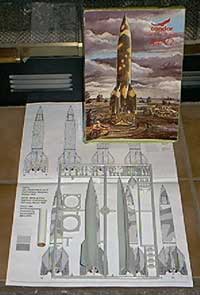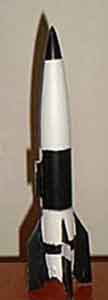Brief:
A plastic model conversion from a Czech-made Condor V-2 rocket model for 13mm
motors.
Construction:
This plastic model conversion was made from the static model made by a Czech
company named Condor. As such, it is made from the typical styrene plastic used
in most static models. The quality of components wasn't as good as, say, Revell
or Monogram, but wasn't too bad either. All the parts to build a static model
V-2 rocket with firing stand were present, attached to plastic runners. This is
a very small V-2 kit, though it appeared larger on the box. Anyway, it seems
that Condor always had PMC in mind, because the original motor nozzle was right
at 13mm! All that was needed was a motor tube, a tapered centering ring, a
launch lug, and a parachute. And, as it turned out, mucho clay for the nose.
Since it was purchased for SoAR's inaugural Plastic Death meet, time was
running out. A coin was tossed, and command of the V-2 was turned over to my
middle son, Josh.

It couldn't be any simpler. This little V-2 seemed destined to be a flying kit from the start. Once both halves of the body were taped together, the body was sawed in half at the indentation cast into the body. Funny, I had never noticed this ring in any photos of V-2s until I saw this model. Anyway, once the body was sawed in half, the lower two halves were glued together with CA. Once dry, the motor tube was put in place, and held in with a couple of centering rings made from Styrofoam construction board, in decreasing radii. This filled the tail cone nicely. We decided to leave a lot of motor tube extending into the upper body tube, so that a composite "B" motor could be used. Several layers of the Styrofoam board were used to build something for the upper body tube to attach itself to. A length of elastic cord was attached to the motor tube with a snap swivel. The upper body was glued together with CA, and the nose was filled with clay, though not enough, as the first flight showed. The upper shock cord was attached with the Estes-style folded paper epoxied to the plastic. Finally, the fins were attached with CA, and the whole thing was covered in gray primer. We decided to paint it like V-2 number 2, which was the first of this roll pattern. The paint wasn't the greatest, but...
Flight:
For the maiden voyage, an Estes A10-3T was used. A chunk of cellulose wadding
was used, but not enough. The motor retention was simply friction fit, though
that's trickier on a 13mm motor than it is on a 29mm motor! Unlike the real
V-2, this beastie took off with a bang. It flew straight and true to motor
burnout, then a severe wobble set in. More nose weight needed! But there was
not enough cellulose wadding, and the `chute (pirated from Obelisk) burned
severely, and it recovered at a good speed. No damage other than a burnt shock
cord and a melted chute! Once repairs were made, it was time for the SoAR meet.
On a windy January day, the first competition flight was flawless, but still
with a slight wobble. Altitude with an A10-3T was about 75 feet. At apogee, the
nose popped perfectly, but the chute twisted in the wind, and though it worked,
it didn't expand fully. Still, absolutely no damage. Josh was really happy with
it, and I was pretty encouraged by its performance.
Summary:
Main pro's: bulletproof as a brick, unique, and surprisingly easy enough for a
pre-teen to build. Con's: A LOT of nose weight needed, and a very V-2 like
flight characteristic of wobbling. Still, we will most likely build a whole
fleet of these little rockets. How about a Russian post-war V-2 with parallel
staged 10.5mm Micro motors? Hmmm...
Plastic model conversion is a blast!
Sponsored Ads
 |
 |











